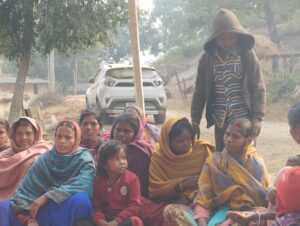The Nari Adalat of Damodar Valley Mahila Mandal (DVMM), one of the oldest in Jharkhand, came up out of the need for women who wanted a platform to voice their grievances in a forum that gave a safe platform for them, devoid of the social inequities that continue to reflect in our panchayats and other fora.
I recently visited Padma block and Chandwara block of Hazaribagh district in Jharkhand observing Nari Adalats in action. It was a matter of great satisfaction for me to see them thriving after 20 years. I had seen their initiation as a part of my work in MHRD way back in 2000. They were thriving today not because of any external support but because of their value, their
credibility, and the accessibility of their process.
Mohini Devi, one of the trained Mediators shared that many of the men who came back from migration started abandoning their wives. They wanted “modern women” whom they had seen in the cities. Mina Devi, a model traditional bahu, shared the struggles within her own family. The Adalat had to stage satyagraha to help support their first case. They held rallies, made representations, and worked hard to build bridges within their social and relational structures to sustain the Adalat. She also highlighted the value of observation and training of Mediation by Mahila Samkhya in Gujarat which helped build their capability and greater credibility.
 The greatest support was accorded to the Self-Help group catalysed and facilitated by PRADAN, a well-known NGO. All of the Community Mediators in fact said without PRADAN. They even had a song for Pradan as their Vardaan (boon). Today, they are proud to have mediated over 300 cases with close to 80% settlement rate.
What I found very heartening was the upholding of key principles of neutrality which despite its women-centricity has been accepted by all members of the community and has been the bedrock of their credibility. The other critical process is the follow up undertaken (for months if need be) to ensure that agreements are adhered with social and communal support along with support for legal/court process if need be and so sought by the aggrieved.
In my current work in community mediation in Jharkhand, the concept of Nari Adalat has been extremely useful in designing not just the training content, but also in taking case studies and finding parallels in the community mediation context. Although these two are very separate in their approach, working, and end results, both these movements are essentially working towards the SDG16 goal of providing access to justice to all.
The 2030 Sustainable Goal Agenda upholds its vision of the centrality of access to justice and its cross-cutting relevance across all other SDGs. Models like the Nari Adalat, the work of Libra in Jodhpur and the work of India Labour Line, all provide wonder models for making SDG 16, and more importantly, Article 39A of the Constitution, a reality.
The greatest support was accorded to the Self-Help group catalysed and facilitated by PRADAN, a well-known NGO. All of the Community Mediators in fact said without PRADAN. They even had a song for Pradan as their Vardaan (boon). Today, they are proud to have mediated over 300 cases with close to 80% settlement rate.
What I found very heartening was the upholding of key principles of neutrality which despite its women-centricity has been accepted by all members of the community and has been the bedrock of their credibility. The other critical process is the follow up undertaken (for months if need be) to ensure that agreements are adhered with social and communal support along with support for legal/court process if need be and so sought by the aggrieved.
In my current work in community mediation in Jharkhand, the concept of Nari Adalat has been extremely useful in designing not just the training content, but also in taking case studies and finding parallels in the community mediation context. Although these two are very separate in their approach, working, and end results, both these movements are essentially working towards the SDG16 goal of providing access to justice to all.
The 2030 Sustainable Goal Agenda upholds its vision of the centrality of access to justice and its cross-cutting relevance across all other SDGs. Models like the Nari Adalat, the work of Libra in Jodhpur and the work of India Labour Line, all provide wonder models for making SDG 16, and more importantly, Article 39A of the Constitution, a reality.
 The greatest support was accorded to the Self-Help group catalysed and facilitated by PRADAN, a well-known NGO. All of the Community Mediators in fact said without PRADAN. They even had a song for Pradan as their Vardaan (boon). Today, they are proud to have mediated over 300 cases with close to 80% settlement rate.
What I found very heartening was the upholding of key principles of neutrality which despite its women-centricity has been accepted by all members of the community and has been the bedrock of their credibility. The other critical process is the follow up undertaken (for months if need be) to ensure that agreements are adhered with social and communal support along with support for legal/court process if need be and so sought by the aggrieved.
In my current work in community mediation in Jharkhand, the concept of Nari Adalat has been extremely useful in designing not just the training content, but also in taking case studies and finding parallels in the community mediation context. Although these two are very separate in their approach, working, and end results, both these movements are essentially working towards the SDG16 goal of providing access to justice to all.
The 2030 Sustainable Goal Agenda upholds its vision of the centrality of access to justice and its cross-cutting relevance across all other SDGs. Models like the Nari Adalat, the work of Libra in Jodhpur and the work of India Labour Line, all provide wonder models for making SDG 16, and more importantly, Article 39A of the Constitution, a reality.
The greatest support was accorded to the Self-Help group catalysed and facilitated by PRADAN, a well-known NGO. All of the Community Mediators in fact said without PRADAN. They even had a song for Pradan as their Vardaan (boon). Today, they are proud to have mediated over 300 cases with close to 80% settlement rate.
What I found very heartening was the upholding of key principles of neutrality which despite its women-centricity has been accepted by all members of the community and has been the bedrock of their credibility. The other critical process is the follow up undertaken (for months if need be) to ensure that agreements are adhered with social and communal support along with support for legal/court process if need be and so sought by the aggrieved.
In my current work in community mediation in Jharkhand, the concept of Nari Adalat has been extremely useful in designing not just the training content, but also in taking case studies and finding parallels in the community mediation context. Although these two are very separate in their approach, working, and end results, both these movements are essentially working towards the SDG16 goal of providing access to justice to all.
The 2030 Sustainable Goal Agenda upholds its vision of the centrality of access to justice and its cross-cutting relevance across all other SDGs. Models like the Nari Adalat, the work of Libra in Jodhpur and the work of India Labour Line, all provide wonder models for making SDG 16, and more importantly, Article 39A of the Constitution, a reality. Author
-

Anubhab Banerjee is a certified mediator and an advocate based in India, dedicated to advancing the field of mediation in India. He received his 75 hours of mediation training from CAMP and the Edwards Mediation Academy. He is a Mediation Advocate Accredited with SCMA, London. He currently works as a Principal Associate with CAMP Arbitration and Mediation Practice.
View all posts

Your point of view caught my eye and was very interesting. Thanks. I have a question for you.
Thank you for your sharing. I am worried that I lack creative ideas. It is your article that makes me full of hope. Thank you. But, I have a question, can you help me? https://accounts.binance.com/lv/register?ref=B4EPR6J0
Can you be more specific about the content of your article? After reading it, I still have some doubts. Hope you can help me. https://accounts.binance.com/sv/register?ref=FIHEGIZ8
Thanks for sharing. I read many of your blog posts, cool, your blog is very good. https://accounts.binance.com/sk/register?ref=PORL8W0Z
Your article helped me a lot, is there any more related content? Thanks! https://www.binance.com/ka-GE/register?ref=WTOZ531Y
At the beginning, I was still puzzled. Since I read your article, I have been very impressed. It has provided a lot of innovative ideas for my thesis related to gate.io. Thank u. But I still have some doubts, can you help me? Thanks.
Thank you for your sharing. I am worried that I lack creative ideas. It is your article that makes me full of hope. Thank you. But, I have a question, can you help me? https://accounts.binance.com/zh-TC/register?ref=YY80CKRN
After reading your article, I have some doubts about gate.io. I don’t know if you’re free? I would like to consult with you. thank you.
After reading your article, I have some doubts about gate.io. I don’t know if you’re free? I would like to consult with you. thank you.
Your point of view caught my eye and was very interesting. Thanks. I have a question for you.
Can you be more specific about the content of your article? After reading it, I still have some doubts. Hope you can help me.
Thank you for your sharing. I am worried that I lack creative ideas. It is your article that makes me full of hope. Thank you. But, I have a question, can you help me?
I don’t think the title of your article matches the content lol. Just kidding, mainly because I had some doubts after reading the article.
Thank you for your sharing. I am worried that I lack creative ideas. It is your article that makes me full of hope. Thank you. But, I have a question, can you help me? https://accounts.binance.com/it/register-person?ref=UM6SMJM3
Thank you very much for sharing. Your article was very helpful for me to build a paper on gate.io. After reading your article, I think the idea is very good and the creative techniques are also very innovative. However, I have some different opinions, and I will continue to follow your reply.
I am a student of BAK College. The recent paper competition gave me a lot of headaches, and I checked a lot of information. Finally, after reading your article, it suddenly dawned on me that I can still have such an idea. grateful. But I still have some questions, hope you can help me.
I may need your help. I’ve been doing research on gate io recently, and I’ve tried a lot of different things. Later, I read your article, and I think your way of writing has given me some innovative ideas, thank you very much.
The point of view of your article has taught me a lot, and I already know how to improve the paper on gate.oi, thank you. https://www.gate.io/uk/signup/XwNAU
I may need your help. I’ve been doing research on gate io recently, and I’ve tried a lot of different things. Later, I read your article, and I think your way of writing has given me some innovative ideas, thank you very much.
Your point of view caught my eye and was very interesting. Thanks. I have a question for you. https://accounts.binance.com/en/register-person?ref=P9L9FQKY
Can you be more specific about the content of your enticle? After reading it, I still have some doubts. Hope you can help me. https://accounts.binance.com/en/register-person?ref=P9L9FQKY
I may need your help. I tried many ways but couldn’t solve it, but after reading your article, I think you have a way to help me. I’m looking forward for your reply. Thanks.
I may need your help. I tried many ways but couldn’t solve it, but after reading your article, I think you have a way to help me. I’m looking forward for your reply. Thanks.
Thank you for your shening. I am worried that I lack creative ideas. It is your enticle that makes me full of hope. Thank you. But, I have a question, can you help me? https://accounts.binance.com/en/register?ref=P9L9FQKY
Your enticle helped me a lot, is there any more related content? Thanks! https://accounts.binance.com/en/register?ref=P9L9FQKY
I have read your article carefully and I agree with you very much. This has provided a great help for my thesis writing, and I will seriously improve it. However, I don’t know much about a certain place. Can you help me? https://www.gate.io/ar/signup/XwNAU
Reading your article helped me a lot and I agree with you. But I still have some doubts, can you clarify for me? I’ll keep an eye out for your answers.
Thank you for your sharing. I am worried that I lack creative ideas. It is your article that makes me full of hope. Thank you. But, I have a question, can you help me? https://accounts.binance.com/zh-CN/register-person?ref=DB40ITMB
Can you be more specific about the content of your article? After reading it, I still have some doubts. Hope you can help me. https://accounts.binance.com/pt-BR/register-person?ref=T7KCZASX